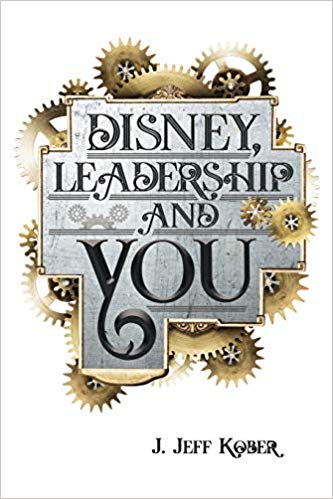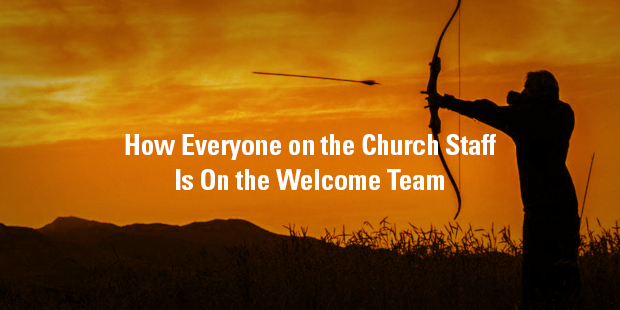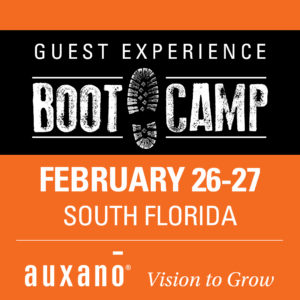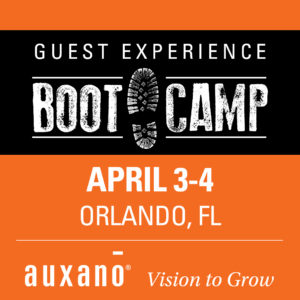At Auxano, we’ve walked with more than 500 churches through a process called the Guest Perspective Evaluation. And when they’re done, they all ask, “What’s next?”
Amazingly, most church leaders don’t actually have a plan they can use to improve their Guest Experience!
Ask them about their strategy and you’ll discover it boils down to this:
We’ll be friendlier.
It’s understandable. Church leaders are too busy on the weekend to actually understand what Guests see – and experience – to really know how to make things better. After all, your church is “friendly,” right? And that is all you need to have a good Guest Experience.
But why settle for good?
An exceptional Guest Experience ministry doesn’t have to be complicated. We recommend you execute on just three things:
- Place
- Process
- People
Focusing on these three things will allow you to welcome first time Guests, welcome back returning Guests, and create a culture of hospitality within your church that extends your ministry beyond your walls.
The catch?
Each of these three elements shares one requirement: paying attention to details.
It’s impossible to have an exceptional Guest Experience unless you pay attention to details.
This is such an important principle that we are devoting two issues of SUMS Remix to this concept. What is SUMS Remix? It’s one of the other great parts of my job: a “book excerpt” published every two weeks, with each issue listing excerpts from three books addressing a challenging problem leaders face.
I typically reprint sections of SUMS Remix from prior years on my other website, 27gen. However, August is a month-long focus on Guest Experience, and I’m pleased to be able to reproduce excerpts from these special issues of SUMS Remix here.
For the first issue, we will look at the three components of an EXCEPTIONAL Guest Experience, with lessons from the world leader in Guest Experience – the Disney organization. The second issue will highlight lessons from another area of hospitality – the pro chef’s kitchen – on how churches can provide an EXCEPTIONAL Guest Experience.
Want to learn how to create an EXCEPTIONAL Guest Experience at your church? Check out Auxano’s Guest Experience Boot Camp, coming to Orlando, FL on April 3-4.
The PEOPLE involved in welcoming Guests
THE QUICK SUMMARY – Creating Magic, by Lee Cockerell
The secret for creating “magic” in our careers, our organizations, and our lives is simple: outstanding leadership—the kind that inspires employees, delights customers, and achieves extraordinary business results.
No one knows more about this kind of leadership than Lee Cockerell, the man who ran Walt Disney World® Resort operations for over a decade. And in Creating Magic, he shares the leadership principles that not only guided his own journey from a poor farm boy in Oklahoma to the head of operations for a multibillion dollar enterprise, but that also soon came to form the cultural bedrock of the world’s number one vacation destination.
But as Lee demonstrates, great leadership isn’t about mastering impossibly complex management theories. We can all become outstanding leaders by following the ten practical, common sense strategies outlined in this remarkable book.
Combining surprising business wisdom with insightful and entertaining stories from Lee’s four decades on the front lines of some of the world’s best-run companies, Creating Magic shows all of us – from small business owners to managers at every level – how to become better leaders by infusing quality, character, courage, enthusiasm, and integrity into our workplace and into our lives.
A SIMPLE SOLUTION
Walt Disney knew the value of learning as much as possible about the front lines by spending time on the front lines.
The time on the front lines meant paying attention to the details the people were experiencing – and that meant people on both sides: the Guests and the Cast Members interacting with them.
Walt would regularly walk through the Park, looking for problems or things to improve. He was good at it and always welcomed suggestions. I copied his routine. I continually walked through the Park, looking for different things, people problems. Facts are easy to identify; I was looking for feelings that were bothering Cast Members.
– Van France, founder of Disney University
Walt Disney had established a priority in which leaders never stopped looking at Disneyland from the perspective of the Guest, learning a tremendous amount from these encounters.
No matter what kind of work you do, it you aspire to truly great leadership, you need to get all the facts pertaining to your operation. And to do this, there is no substitute for getting out of your office and onto the front lines of your organization.
The truth is out there – on the front lines. The following tips will help you find it.
- Get out and about regularly. Even though he was busy running one of the world’s biggest entertainment empires, Walt Disney used to spend a great deal of time walking around Disneyland, speaking to Guests and Cast Members. And he expected his team to do the same, as well. A long list of innovations and improvements grew directly from those close encounters with the Guest experience.
- Get a ground level view. To the degree it’s possible, observe your operations the way your Guests see them.
- Meet regularly with direct reports. Don’t just ask your direct reports if everything is OK and take “yes” for an answer. Everything is never OK. Hold substantive meetings with them on a regular basis.
- Assemble small groups. One of the most effective ways to gather information is to bring employees together to talk. A group of ten or twelve people is the best size as it gives you a diversity of viewpoints while remaining intimate enough for everyone to feel relaxed and have enough time to speak.
- Probe for the whole story. People won’t always tell you everything you need to know. It’s not so much that they lie as that they out significant details. Pay close attention to what’s being said and what’s not being said when talking to your employees.
Lee Cockerell, Creating Magic
A NEXT STEP
Review the five tips above with your team, asking if any of the team has used one or more of the tips before. If they have, ask for the backstory and lessons learned.
Emphasize the importance of interacting with the front lines, observing both team members and Guests, by discussing the following questions.
Gather Facts and Feelings
In your organization, can you identify the values that support walking the front lines and keeping in touch them? How do you apply those values in gathering facts and feelings from team members and Guests?
“Walk the Park”
- What is the equivalent of walking the park in your organization? Who does it, and how frequently?
- How could this strategy be improved? More people involved? More frequently?
- If leaders aren’t walking the park, what is the excuse?
- Walt Disney could carve time out of his day to walk the park. Why can’t every leader do that?
Mind the Gap
- Is there a reality gap between the ideals espoused in your organization and training programs and the realities of the job?
- How is the effectiveness of your training assessed? With what frequency?
One Foot in the Past, One Foot in the Future
- How is the history of your organization kept alive? How could this be improved?
- How does your organization balance history and legacy with current and future needs? Who supports this?
Excerpt taken from SUMS Remix 72-3, issued August 2017.
This is part of a weekly series posting excerpts from one of the most innovative content sources in the church world: SUMS Remix Book Summaries for church leaders.
SUMS Remix takes a practical problem in the church and looks at it with three solutions; each solution is taken from a different book. Additionally, a practical action step is included with each solution.
As a church leader you get to scan relevant books based on practical tools and solutions to real ministry problems, not just by the cover of the book. Each post will have the edition number which shows the year and what number it is in the overall sequence. (SUMS Remix provides 26 issues per year, delivered every other week to your inbox).
>> Subscribe to SUMS Remix <<
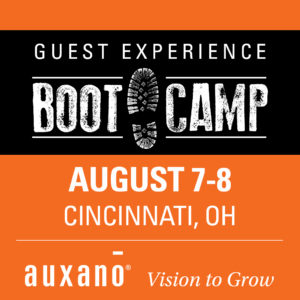
Want to learn how to create an EXCEPTIONAL Guest Experience? Check out Auxano’s Guest Experience Boot Camp in Cincinnati, OH on August 7-8.

Tags: Church Guest Experiencses, Creating Magic, Guest Experiences, Lee Cockerell, SUMS Remix, front line
|
What is MyVisionRoom? > | Back to Execution >




















